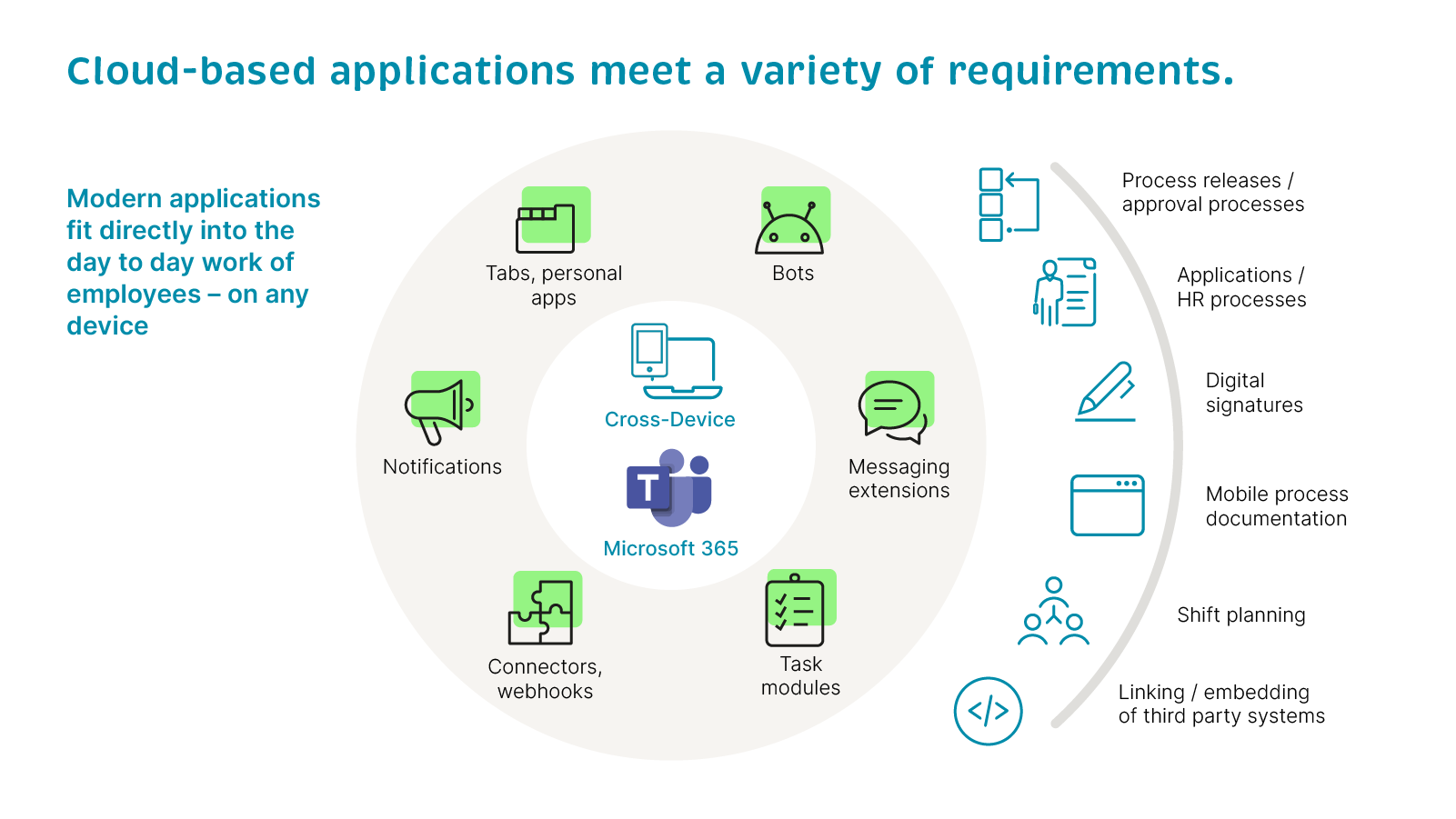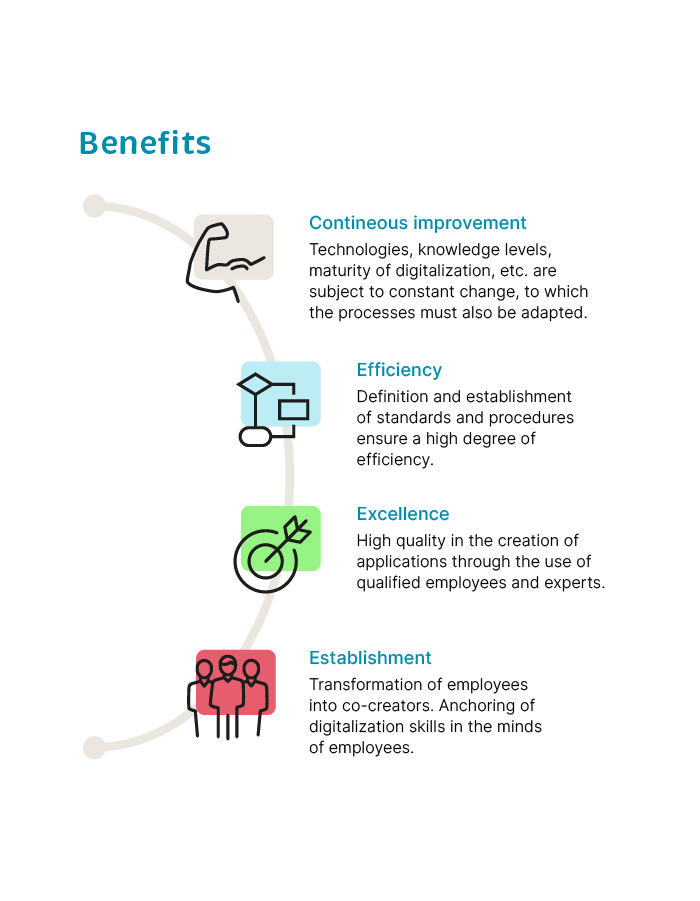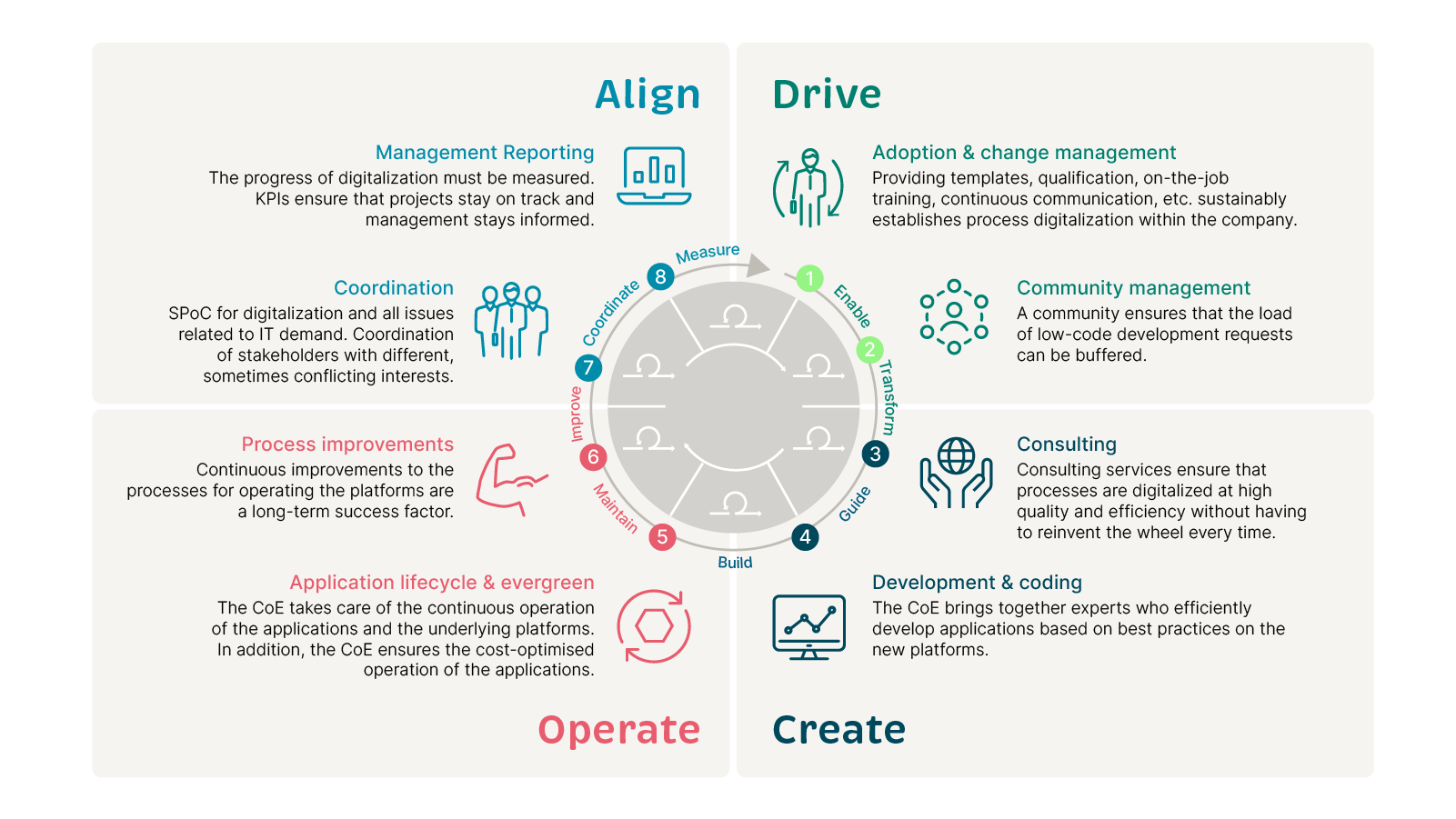Many ways of working have already been sustainably modernized. At the same time, employees' expectations of the applications they use are rising. In order for companies to reap the benefits of cloud transformation, such as greater flexibility and efficiency, the next step must now follow: making the business and specialist applications usable via the cloud so that there are no delays in the work processes. One example: Business-critical contract conclusions or offers should also be sent smoothly and immediately to customers from the home office. Who can and wants to put off their customers until the next day just because a template is not available remotely? This is where a comprehensive cloud transformation creates lean processes, high availability and always up-to-date applications.
We set up a CCoE at the customer to accelerate and anchor the development of business applications. We will provide best practice processes for consulting, creation, deployment, ACM and operation (incl. platform). In partnership with the customer, we will take over selected tasks, in particular for scaling the development.


For IT departments, the transformation to the cloud enterprise of the future brings some challenges that should be solved competently. Because they are not only busy with the migration, the management of the cloud services and new developments. The existing applications and infrastructure also want to be operated.
External management and technology consulting professionals are there to support them with their know-how in every phase of the cloud transformation. An important milestone is the early establishment of the necessary core competencies for the subsequent operation of the infrastructure, ideally in a Cloud Center of Excellence (CCoE).
Competently mastering the challenges of the IT department
IT departments are now faced with the challenge of having to continue to operate legacy applications and thus infrastructure, in addition to managing modern cloud services.
Companies have often planned to migrate their own computing capacities to the cloud in the short term in order to be able to close their own data centers, among other things. In some cases, servers are migrated for this purpose, and in others applications, including cloudnative ones, are redesigned or purchased as a service.
In addition, the IT department is confronted with requests from the business departments to provide more and more applications in the modern digital workplace. Parallel to regular operations, IT departments must therefore evaluate a large number of existing and new applications, design and develop the new apps, and operate all applications.
Beyond its tasks as an organizational unit, IT must position itself as a competence bearer and business enabler of the digital transformation in order to be recognized as a partner of the business departments and to help shape business success in the long term.

What a Cloud Center of Excellence (CCoE) does
How can these tasks be solved and the applications provided at the desired speed and quality? Regular structures and processes often fail to do this - so an alternative is needed.
In a Cloud Center of Excellence (CCoE), experts from different areas can work together to overcome existing line-of-business assignments and thus significantly accelerate coordination processes. The goal is to achieve business and technical agility. This applies to all phases: in the course of cloud introduction, during increasing cloud automation and for the period after cloud transformation. Evaluation criteria such as cost, flexibility, complexity and speed are at the heart of operational and also development issues.
The CCoE makes a significant contribution to overcoming existing structures and silos and working together in an interdisciplinary manner to involve as many company divisions as possible for a paradigm shift towards cloud-based architectures. The way of working is comparable with the DevOps approach.
Experts for cloud application development are bundled in the CCoE - requirements engineers can record and design requirements with the specialist departments based on available technologies. Technology experts from the CCoE can be integrated and provide support for the corresponding release processes - specialists for operation and support can also be found in a well-positioned CCoE. They guarantee the secure operation of the solutions provided. These profiles primarily address the requirement to position IT as a partner to the business for the provision of modern solutions. The CCoE continues to be supplemented by professionals for the basic implementation, governance and operation of required base platforms (e.g., Azure) that ensure long-term use.
External partners can help companies pool knowledge here and initiate cloud competencies for long-term continuous improvement and future change. In practice, it has been shown that companies can quickly build knowledge in mixed teams between external partners and their own resources and then adopt it independently.
A major advantage of the CCoE is that a Cloud Center of Excellence enables IT managers to scale much faster. In this way, companies quickly build up expertise in cloud technologies in a team, before it is a question of transferring the initiated processes to the line in a further downstream step.

Cloud Strategy

What might such a project look like? A customer from the high-tech sector in the energy industry has already relaunched Microsoft 365. Now he wants to migrate the on-premise data center to the cloud so that all data is available at the digital workstations.
The customer has already deployed Azure and Power Platform as the enabling technologies in addition to M365. Based on these technologies, the right strategy for the migration of existing applications and new development of new requirements from the business departments can be worked out. The focus here is on the question: Where is which enterprise application best mapped?
In a Cloud Center of Excellence (CCoE), which Campana & Schott is setting up together with the experts from the company, everyone works together in one organizational unit and is responsible for the entire cloud migration. To this end, the CCoE manages the transition of applications to cloudnative applications in an agile lifecycle: from requirements gathering and development to operation and agile further development, also using existing building blocks.
Campana & Schott assumes specialist roles in the CCoE if no internal expertise is available, for example in application development or requirements elicitation. The CCoE enables the company to quickly build up cloud expertise and create new structures for cross-departmental collaboration. In the CCoE, the requirements of the different business units are optimized and cloudnative applications are implemented significantly faster.

Conclusion
The shift of business processes and applications to the cloud brings numerous advantages for companies: Costs can be reduced, development times and time-to-market accelerated, and business processes made more efficient. In order for companies to benefit comprehensively from all the advantages of cloud transformation, they should bundle competencies in a CCoE, build up cloud knowledge there and collaborate in an agile manner across disciplines. In this way, the company achieves cloud excellence through continuous improvements. In addition, it is important to anchor the cloud not only among specialists, but to sensitize and fascinate all employees.

